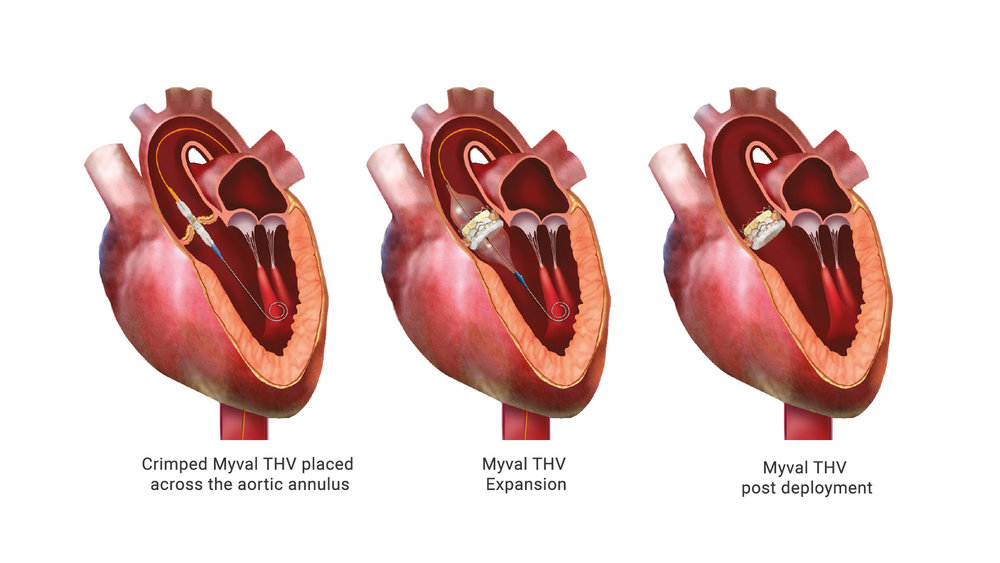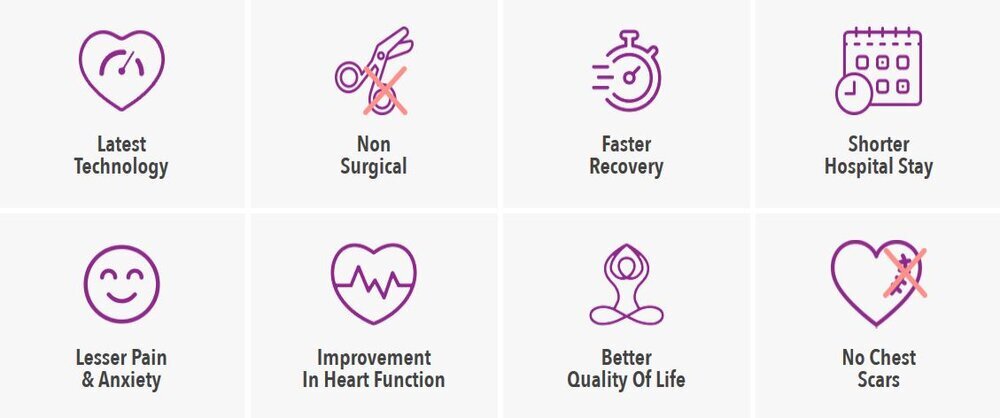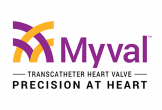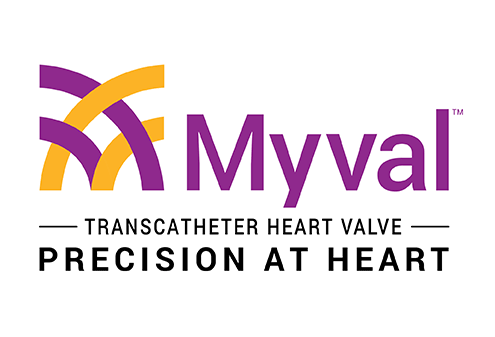





TAVR Procedure For Aortic Heart Valve Replacement- (TAVR)
What is TAVR /TAVI Procedure?
-
Transcatheter aortic valve replacement (TAVR) or Transcatheter aortic valve implantation (TAVI) is the nonsurgical option. This technique is a life-saving treatment modality for patients who are unwilling or at risk to undergo an open heart surgery. This novel, interventional technique is somewhat similar to angioplasty and is done in the Cardiac Catheterization Lab (Cath-lab).
-
Till date, valve replacement has been mostly done through open heart surgery wherein a new tissue/mechanical prosthetic valve is inserted in place of the diseased valve.
-
Open heart surgery is an invasive procedure and is known to have a longer recovery time and may be challenging for elderly patients (>65 yrs).
-
Transcatheter Aortic Valve Replacement (TAVR) technique is a life-saving treatment modality for patients who are unwilling or at risk to undergo an open heart surgery.
-
This minimally invasive procedure involves placement of a new valve over the patient’s diseased valve via a catheter inserted through the femoral artery (large artery in groin).
-
This procedure can thus be done through small openings and hence result in quicker recovery post procedure.
-

TAVR procedure steps
What To Do Before TAVR Procedure?
You will be treated by an expert ‘Heart team’ of specialists which includes an interventional cardiologist, cardiac surgeon, radiologist, anesthesiologist, intensive care expert, nurses and some others.
Exercise: Ask your doctor about the maximum amount of physical activity that you can perform and what activity you should avoid before some days of your TAVR.
Medicines: Your Heart team might advise you to stop taking certain medication up to one week prior to the procedure.
Diet: Consult your doctor about any diet recommendations that you have to follow. Your doctor may tell you not to eat or drink anything after midnight of the day prior to the procedure.
Dental Health: As bacteria in the mouth can cause valve infection, it is important that you visit your dentist before your TAVR to check that you have good dental health.
Recovery Plan: It is important to make prior arrangement on a ride to and from the hospital, and arrange for help at home after the procedure.
5 Steps of TAVR /TAVI Procedure
-
-
Week before TAVR: You might receive a call for confirmation of your appointment and provide you brief information on when to reach the hospital. You will be advised about discontinuing or continuing your current medicines and diet restrictions.
-
Day of TAVR: You will be admitted to the hospital on the day or the day prior to your procedure.
-
Pre-procedural Care: An intravenous instead of IV line will be introduced into your arm. You will go through some blood tests, ECG/EKG, and an X-ray of the chest. Consent will be obtained and an antiseptic scrub will be used to prepare the access site.
-
Day of Your Procedure: You will be wheeled into the cardiac catheterization laboratory (Cath Lab) holding area where you will be evaluated by a nurse and anesthesiologist. Then, you will be taken to the procedure room. In procedure room, you will be attached to the monitoring equipment. Permission will be taken and the access site will be shaved and prepared using an antiseptic scrub. You will be given sleep medicines (anesthesia) through the IV line.
-
TAVR Procedure using a Balloon-Expandable Valve (Transfemoral route): Imaging techniques will be used to help the doctors during the TAVR procedure. A small incision will be made in your groin where your doctor will insert a short, hollow tube called a sheath. Your new valve will be placed on a Navigator delivery system and compressed on the balloon to make it small enough to fit through the sheath. When the delivery system reaches the diseased valve, balloon will be inflated to open the new valve within the diseased valve. The balloon will then be deflated and removed. Immediately after this, the new valve will start working. The sheath will be removed and the incision in your leg will be closed.
-
What After TAVR Procedure?
Intensive Care Unit (ICU) after the Procedure: You will be shifted to the ICU after your procedure. You will remain here for 24-48 hours or until you become stable. You will be closely monitored here and will undergo a detailed physical examination involving some blood tests, a chest X-ray, an ECG, and an echocardiogram (24 hours after procedure) to ensure that your recovery is proper. Once you are stable, you will be transferred to the patient room where you will be kept for another 1-2 days.
What Are The Benefits To Expect After TAVR Procedure?
More energy and active daily routine, Regaining ability to take care of self, Normal breathing and reduced anxiety

Benefits of TAVR Procedure
Listen to Mr V.K. Anand who managed to overcome the aortic stenosis disease at the age of 79 and is living a healthy life.
The Myval-THV TAVR (Aortic Heart valve) is a biological tissue valve designed to work like your own heart valve. It is available in multiple sizes and your specialized Heart Team will determine which size is right for you. Various clinical studies have shown Myval TAVR procedure to have a lower incidence of death and stroke compared to open heart surgery. TAVR may shorten recovery time to allow patients to get back to everyday activities. Patients have reported quality of life improvements within 30 days including the ability to take care of themselves.
Life After TAVR procedure (Recovery Period)
In most cases, patients begin walking within a day of their TAVR procedure. Average length of hospital stay is around 3-5 days.
Care for the Procedure Site:
Carefully inspect the site daily, being sure to first wash your hands.
Once discharged, you may take a shower and softly wash the site with plain soap and water, but do not take a bath, soak in water, or swim for two weeks after the procedure.
Keep the site clean and dry. Do not apply lotions, powders, or ointments.
Do not leave the bandage dressing for more than a day on the site.
If the access site was the groin (transfemoral): There may be some bruising and tenderness at the access site, which is expected and normal. You may notice a small lump in the groin which will dissolve on its own in about 4-6 weeks.
If the access site required an incision under the clavicle or between the ribs: Expect a small amount of firm tissue, tenderness, and bruising at the incision site, which is normal. You may have staples at the incision site and will be instructed when to return to have them removed.
Immediately call your doctor or go to the closest emergency room if you notice:
Bleeding or discharge at the site
Unusual or excessive swelling, pain, or redness
A temperature greater than 101 degrees
Post Procedure Activity:
Avoid lifting heavy objects, excess bending, stretches, push or pull activities for two weeks.
Walking: Begin by trying to walk for 5 minutes daily after discharge. Then, gradually increase the duration as per your convenience. Ask someone to accompany you during the first few walks.
Sit-to-stand Exercise: Try performing 10 sit-to-stand repetitions daily without hand assistance. Increase to performing this activity 2-3 times per day.
It is all-right to slowly climb stairs.
If your TAVR was performed through the groin without any incision, you can drive after 5 days.
Avoid sexual activity until a follow up appointment with your cardiologist.
Your doctor will provide a time frame for when you can return to work.
Medicines:
Your cardiologist may recommend some blood thinners after your TAVR procedure. These will most likely include aspirin and clopidogrel, and you may also be prescribed a blood thinner (anticoagulant).
Never stop taking any medicine unless the doctor advises to do so as it may cause serious medical problems.
Follow up visit:
You may be advised for a follow-up visit to the hospital at 1 month, 3 months, and 1 year after your TAVR procedure. If in between you develop any health concerns, kindly inform your doctor immediately.



